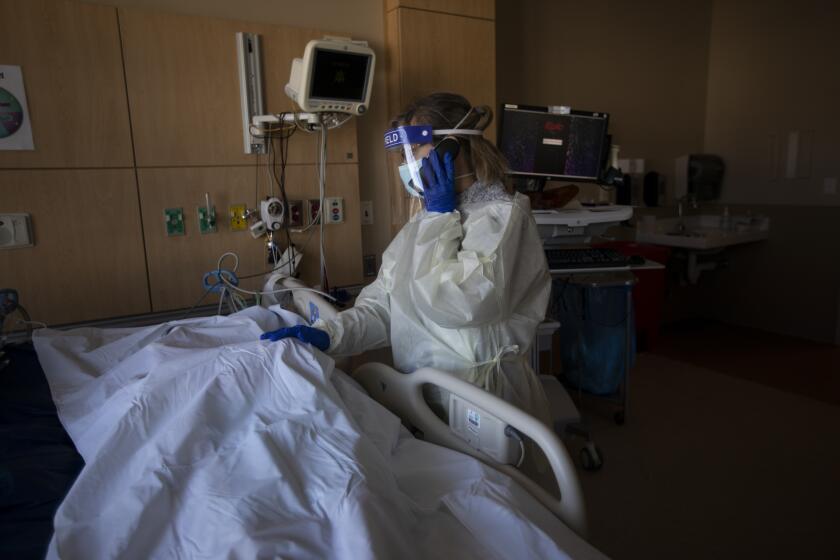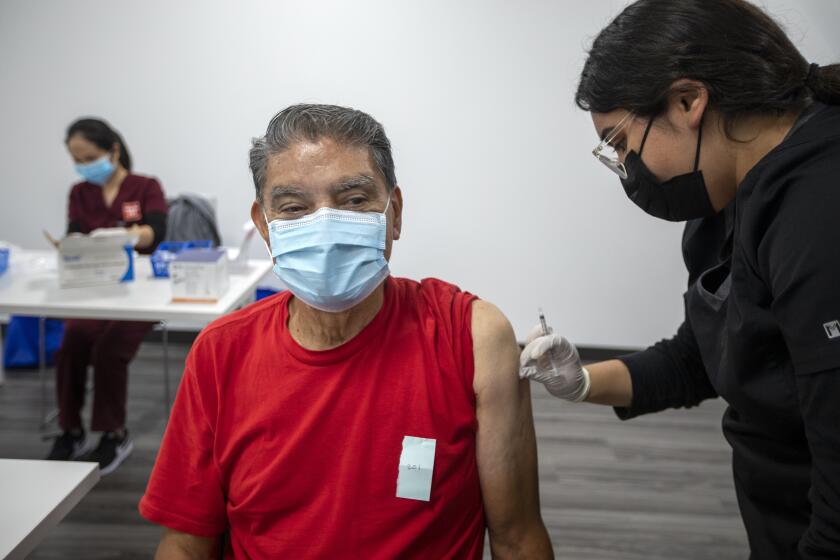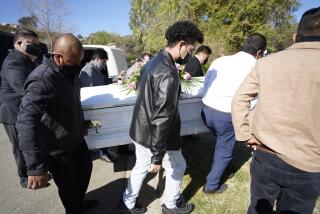How many California lives were saved by COVID-19 vaccines? Scientists have an answer

The arrival of the first COVID-19 vaccines in December 2020 marked the start of a new, safer phase of the pandemic.
For all that we know of life in the vaccine era — the inequities, the breakthrough infections, the partisan battles over mandates — it’s been hard to know what life would have been like without the shots.
A new project from researchers at UC San Francisco in collaboration with the California Department of Public Health draws the clearest picture to date on what the state might have looked like had the vaccines never materialized.
In the first 10 months of their availability, COVID-19 vaccines prevented an estimated 1.5 million coronavirus infections, nearly 73,000 hospitalizations, and almost 20,000 deaths in California, according to a study published Friday in the journal JAMA Network Open.
The number of infections reported during those 10 months was 72% lower than would have been expected in the absence of vaccines, the study added.
“We know that the vaccines work, but what’s been lacking is that understanding of the population-level scale of how much impact these vaccines have had across California,” said Dr. Nathan Lo, an infectious-disease specialist at UCSF and a co-author of the study.
“The impact that vaccines have had, and the findings that we have, are dramatic,” Lo said. Each of those thwarted cases represent an opportunity to “allow people to actually go to work, to be with their family safely, to not have such socioeconomic disruption.”
Deciding how many Americans we are willing to let die of COVID-19 each year is necessary to put the pandemic behind us.
From Jan. 1, 2020 — when few Californians could have heard of the novel coronavirus, much less been exposed to it — to Oct. 16, 2021, the state recorded 4.6 million coronavirus infections. By the end of that period, just over 27 million residents age 12 and older had at least one dose of a COVID-19 vaccine — almost 80% of the eligible population.
To see what a vaccine-less California might have looked like, the study team built a pair of statistical models — essentially, mathematical maps of a world that never was.
For their primary model, the researchers calculated coronavirus infection rates from November 2020 to October 2021 in children 11 and under, the one segment of the state’s population still ineligible for vaccines at the time. Then they applied that infection rate to the rest of the population.
The second model took a different approach. Researchers broke the vaccine-eligible population into four age groups and analyzed the estimated risks of infection, hospitalization and death for each one, alongside the immunity each group gained through vaccination and past infection.
The two models produced strikingly similar results. The primary one showed that the first 10 months of the vaccination campaign forestalled 1.52 million infections, 72,930 hospitalizations and 19,430 deaths. The secondary one estimated that vaccines prevented slightly fewer infections (1.4 million), but more hospitalizations (84,330) and deaths (22,620).
Last year, the Commonwealth Fund, a foundation focused on healthcare for underserved communities, determined that the U.S. vaccination campaign saved a total of 1.1 million American lives and prevented 10.3 million hospitalizations nationwide through Nov. 30, 2021, a period about six weeks longer than the California study covered.
In an updated model posted earlier this month, analysts estimated that vaccines have prevented 66 million U.S. infections, 17 million hospitalizations and 2.2 million deaths and saved $900 billion in healthcare costs since the administration of the first shot to a nurse in New York.
In a large study, the risk of a breakthrough infection was 10 times lower for people who got a COVID-19 booster shot than for people who hadn’t.
The California figures present a more modest effect from the vaccines, but the study authors said they deliberately kept their estimates on the conservative side by leaving out people who could have been infected if vaccinated individuals hadn’t gotten their shots.
“The true numbers are definitely significantly higher, which is even more evidence of the importance of vaccination,” said Sophia Tan, a research data scientist at UCSF and the study’s lead author.
In addition, the models omitted the secondary losses of COVID-19 that never came to pass: the missed days of school or work, the lingering effects of long COVID, the potentially ruinous financial cost of a long illness or hospitalization, the unquantifiable grief.
Each person who dies of COVID-19 leaves behind an estimated nine immediate family members, according to a study in the Proceedings of the National Academy of Sciences.
Tanya Osborne-McKenzie, chief nursing officer at MLK Community Healthcare in Los Angeles, noted that the study also doesn’t account for people unable to get care for other health concerns when hospitals were overwhelmed with COVID-19 patients.
In the early days of the pandemic, “shift to shift, day to day, we had a lot of folks that died,” she said. Martin Luther King Jr. Community Hospital is still full, she said — but with patients seeking care for conditions that might not have been able to be treated in the worst of the pandemic.
“So you see that impact right there,” Osborne-McKenzie said. “We would not have been able to care appropriately for those patients if it weren’t for us mitigating some of the COVID patients.”









